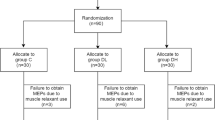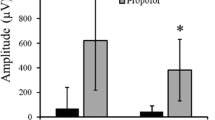Abstract
Objectives. To compare the effects of isoflurane and propofol on intraoperative neurophysiological monitoring (IONM) during spinal surgery. Methods. Thirty-five patients were randomly assigned to receive isoflurane (n = 17) or propofol (n = 18) anesthesia. Somatosensory evoked potentials (SEPs) following posterior tibial nerve stimulation were recorded before induction as baselines. Isoflurane concentrations and propofol infusions were adjusted to obtain four pre-determined BIS ranges: 65–55, 55–45, 45–35 and 35–25. For each range, a stable state was maintained for at least 10 min to perform IONM. The SEP latency P40 and amplitude P40-N50, the onset latency and amplitude of transcranial motor evoked potentials (tcMEPs), and threshold intensity of triggered electromyographic activity (EMG) following pedicle screw stimulation were statistically analyzed. Results. Compared with baseline values, P40 latency increased and P40-N50 amplitude decreased after anesthesia with isoflurane or propofol. Isoflurane caused a dose-dependent depression of SEPs, but propofol did not. TcMEPs were recordable and stable in all patients receiving propofol in each BIS range, but only recordable in 10 (58.8%) receiving isoflurane with BIS > 55, and 3 (17.8%) with BIS < 55. No difference was noted in triggered EMG. Conclusions. Isoflurane inhibited IONM more than propofol. Propofol is recommended for critical spinal surgery, particularly when motor pathway function is monitored.
Similar content being viewed by others
References
Calancie B, Harris W, Broron JG, Alexeeva M, Green BA. Threshold-level multipulse transcranial electrical stimulation of motor cortex for intraoperative monitoring of spinal motor tracts: description of method and compression to somatosensory evoked potential monitoring. Neurosurgery 1998; 88: 457–470.
Holland NR. Spine update: Intraoperative electromyography during thoracolumbar spinal surgery. Spine 1998; 23(17): 1915–1922.
Lenke LG, Padberg AM, Russo MH, Bridwell KH, Gelb DE. Triggered electromyographic threshold for accuracy of pedicle screw placement: An animal model and clinical correlation. Spine 1995; 20(4): 1585–1591.
Maurette P, Simeon F, Castagnera L, Esposito J, Macouillard G, Heraut LA. Propofol anesthesia alters somatosensory evoked potentials. Anesthesia 1988; 43: 44–45.
Padberg AM, Bridwell KH. Spinal cord monitoring. Current state of the art. Orthop Clin North Am 1999; 30: 407–433.
Slimp JC. Electrophysiologic intraoperative monitoring for spine procedures. Phys Med Rehabil Clin N Am (United States) 2004; 15(1): 85–105.
Boisseau N, Madany M, Staccini P, Armando G, Martin F, Grimaud D, Raucoules-Aime M. Comparison of the effect of sevoflurane and propofol on cortical somatosensory evoked potentials. Br J Anaesth 2002; 88(6): 785–789.
Ku AS, Hu Y, Irwin MG, Chow B, Gunawardene S, Tan EE, Luk KD. Effect of sevoflurane/nitrous oxide versus propofol anesthesia on somatosensory evoked potential monitoring of the spinal cord during surgery to correct scoliosis. Br J Anesth 2002; 88(4): 502–507.
Kumar A, Bhattacharyaa A, Makhija N. Evoked potential monitoring in anesthesia and analgesia. Anesthesia 2000; 55: 225–241.
Taniguchi M, Nadstawek J, Pechstein U, Schramm J. Total intravenous anesthesia for improvement of intraoperative monitoring of somatosensory evoked potentials during aneurysm surgery. Neurosurgery 1992; 31(5): 891–897.
Glass PS, Bloom M, Kearse L, Rosow C, Sebel P, Mansberg P. Bispectral analysis measures sadation and memory effects of propofol, midazolam, isoflurane, and alfentanil in healthy volunteers. Anesthesiology 1997; 86: 836–847.
Kearse L, Rosow C, Zaslavsky A, Connors P, Dershwith M, Denman W. Bispectral analysis of the electroencephalogram predicts conscious processing of information during propofol sedation and hypnosis. Anesthesiology 1998; 88: 25–34.
Sebel PS, Lang E, Pampil IJ, White PF, Cork R, Jopling M, Smith NT, Glass PS, Manberg P. Multicenter study of bispectral electroencephalogram analysis for monitoring anesthetic depth. Anesth Analg 1997; 84: 891–898.
Albanese SA, Spadaro JA, Lubicky JP, Henderson NA. Somatosensory cortical evoked potential changes after deformity correction. Spine 1991; 16(Suppl): S371–S374.
Nuwer MR, Dawson EG, Carson LG, Kanim LEA, Sherman JE. SEP spinal cord monitoring reduces neurologic deficits after scoliosis surgery: Results of a large multicenter survey. Electroencephalogr Clin Neurophysiol 1995; 96: 6–11.
Owen JH. The application of intraoperative monitoring during surgery for spinal deformity. Spine 1999; 24: 2649–2662.
Nuwer MR. Spinal cord monitoring. Muscle Nerve 1999; 22: 1620–1630.
Sloan TB. Anesthesia during spinal surgery with electrophysiological monitoring. Semin Spine Surg 1997; 9: 302–308.
Wakasugi M, Hirota K, Roth S, Ito Y. The effects of general anaesthetics on excitatory and inhibitory synaptic transmission in area CAI of the rat hippocampus in vitro. Anesth Analg 1999; 88: 676–680.
Ubags LH, Kalkman CJ, Been HD. Influence of isoflurane on myogenic motor evoked potentials to single and multiple transcranial stimuli during nitrous oxide/opioid anesthesia. Neurosurgery 1998; 43(1): 90–94.
Perlik SJ, VanEgeren R, Fisher MA. Somatosensory evoked potential surgical monitoring. Observations during combined isoflurane-nitrous oxide anesthesia. Spine 1992; 17: 273–276.
Author information
Authors and Affiliations
Corresponding author
Additional information
Chen Z, The effects of isoflurane and propofol on intraoperative neurophysiological monitoring during spinal surgery
Rights and permissions
About this article
Cite this article
Chen, Z. The effects of isoflurane and propofol on intraoperative neurophysiological monitoring during spinal surgery. J Clin Monit Comput 18, 303–308 (2004). https://doi.org/10.1007/s10877-005-5097-5
Issue Date:
DOI: https://doi.org/10.1007/s10877-005-5097-5




